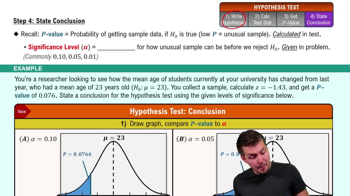In Exercises 55–58, test the claim about the population variance or standard deviation at the level of significance . Assume the population is normally distributed.
Claim: σ^2 > 2; α=0.10. Sample statistics: s^2 = 2.95, n=18
 Verified step by step guidance
Verified step by step guidance Verified video answer for a similar problem:
Verified video answer for a similar problem:



 5:12m
5:12mMaster Intro to Hypothesis Testing with a bite sized video explanation from Patrick
Start learning